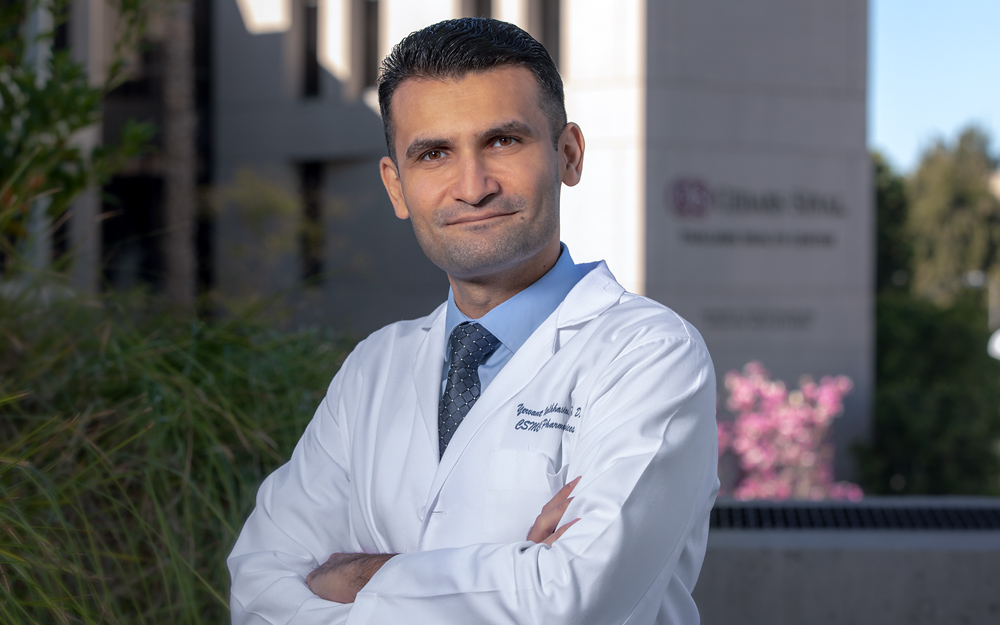Cedars-Sinai Blog
Faces of Cedars-Sinai: Yervant Malkhasian, PharmD
Mar 08, 2023 Cassie Tomlin

Yervant Malkhasian is a transitions of care pharmacist at Cedars-Sinai. He connects with patients about their medications when they check in to the medical center, when they go home and in the months following their hospital visit.
Yervant and his colleagues aim to keep people safe and feeling well by reviewing their treatment regimens and counseling them about their medications. Below, he shares more about this important work.
How do you work with patients?
Yervant Malkhasian: When patients come to the hospital for a stay or a surgery, it’s important for their care teams to know what medications they’re prescribed prior to admission and whether they’re taking them. The transitions of care team, including myself, works hand in hand with doctors and patients at admission and discharge to understand a person’s full clinical picture.
For example, if a patient is prescribed an antibiotic but they come in with an active infection, we first determine whether they are taking that medication. If they are, but it isn’t helping their infection, we know we have to try a different antibiotic. If their report shows they’re taking blood pressure medications, but we see their blood pressure is not controlled, we will evaluate why and adjust their medications.
Why don’t people take the drugs prescribed to them?
YM: There are many reasons people don’t take their medications as prescribed. One big reason is lack of access due to cost or gaps in prescription insurance coverage. Sometimes people stop taking their medications if they don’t see their symptoms improving or out of fear that they will develop side effects. Some patients don’t take all their medications as prescribed because they’re overwhelmed by too many prescriptions.
We know that access to medications is vital to the continued health of patients at our Enhanced Heart Care clinic. There, the nurse practitioners and pharmacist work together with a group of case managers to make sure patients have a safe transition from the hospital to their homes. If patients can’t afford the medications they need or don’t have prescription drug coverage, we explore options to help them cover the cost or start the process of applying for insurance or prescription assistance programs. When we run out of options, we discuss alternate medication solutions with patients and their providers.
Why is it important to follow up with patients after they go home?
YM: Newly diagnosed heart failure patients may leave the hospital with six to 10 new medications, and at follow-up visits, doctors might change these prescriptions or their dosages. It’s important for patients to understand these changes.
During much of the time I spend with patients, we discuss their medication regimen and the risks of not taking medications the right way. An accidental overdose of blood pressure meds could send someone to the hospital with low blood pressure. With blood thinners, if you accidentally take too many, you could develop bleeding. I remind people that even changes to their diet can impact some of the medicines they take—and to consult their healthcare providers before they make any adjustments to their medications.
During post-discharge follow-up visits, we can also identify any drugs a patient isn’t tolerating well so we can explore what can be done to help. We try to understand whether a patient is experiencing unmanageable side effects or whether their body simply needs some time to adjust to a drug.
What is the hardest part about your job?
YM: The hardest part is understanding each patient as an individual. You can have two 65-year-old heart failure patients who need to be approached differently. People’s careers, socioeconomic situations, how much support they have at home and their cultural backgrounds all influence their health and ability to comply with their doctor’s orders. With each patient, I evaluate what I can do to help them figure out how to best take their medications as prescribed.
At the same time, I learn so much by interacting with people from different backgrounds. It’s amazing and important to understand and respect how we’re different and how we’re similar.
What inspired you to pursue this career?
YM: I always knew I would go into healthcare. In Iraq, when you finish high school, you have to decide on a career. I didn’t have much exposure to dentistry, but I completed three years of dental school before I moved to the U.S. and realized it’s not really the field for me. I shadowed some pharmacists I knew and found I could see myself in this career.
I’ve always been inspired by how medications work: how a drug sometimes works for one person but not for someone else. I really enjoy being able to understand how medications work and then explaining that to patients.
What would you do if you weren’t a pharmacist?
YM: If I weren’t a pharmacist, maybe I’d be a goalkeeper. I played a lot of soccer when I was young until I needed to focus on my studies. But now, on weekends, I wake up at 4 or 5 a.m. to watch soccer games being played in Europe. During the World Cup, I recorded all the games so I could watch them after work. I’m really excited that L.A. will be a host for the World Cup in 2026.

